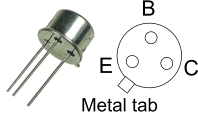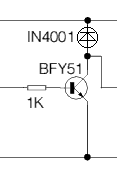BFY51 Transistor: Difference between revisions
From DT Online
m (Added switching application) |
mNo edit summary |
||
| (One intermediate revision by the same user not shown) | |||
| Line 1: | Line 1: | ||
[[File: BFY51.png|250px|right]] | [[File:BFY51.png|250px|right]] | ||
__TOC__ | __TOC__ | ||
=====Description===== | =====Description===== | ||
A '''BFY51''' Transistor is an '''NPN''' ''(Negative-Positive-Negative)'' [https://en.wikipedia.org/wiki/Bipolar_junction_transistor#NPN '''Bipolar Transistor''']: the most commonly used transistor configuration | |||
The '''BFY51''' Collector is connected to the positive (+ve) supply via the load. NB If the load is inductive i.e. has coil windings such as a relay, solenoid or motor, then it is usual to connect a diode across it to prevent the Back EMF from damaging the transistor. (Cathode to supply). The input is connected to the Base via a limiting resistor (typically 1K). The Emitter is connected to the negative (-ve) supply (0V). | The '''BFY51''' Collector is connected to the positive (+ve) supply via the load. NB If the load is inductive i.e. has coil windings such as a relay, solenoid or motor, then it is usual to connect a diode across it to prevent the Back EMF from damaging the transistor. (Cathode to supply). The input is connected to the Base via a limiting resistor (typically 1K). The Emitter is connected to the negative (-ve) supply (0V). | ||
Latest revision as of 09:25, 27 January 2017
Description
A BFY51 Transistor is an NPN (Negative-Positive-Negative) Bipolar Transistor: the most commonly used transistor configuration
The BFY51 Collector is connected to the positive (+ve) supply via the load. NB If the load is inductive i.e. has coil windings such as a relay, solenoid or motor, then it is usual to connect a diode across it to prevent the Back EMF from damaging the transistor. (Cathode to supply). The input is connected to the Base via a limiting resistor (typically 1K). The Emitter is connected to the negative (-ve) supply (0V).
Features and Applications
Uses: As current amplifiers and electronic switches, for example, Motor Drive Amplifiers, Audio Amplifiers.
Data: Voltage between Collector and Emitter 6 - 30Volts max.
- Power handling capacity 800mWatts max.
- Current handling capacity 1 Amp max.
- Amplification (gain) greater than 50.
Note: Older Transistors such BFY51 may sometimes be difficult to obtain but 2N3053 is a good substitute (i.e. it is NPN, can operate with similar voltage and current and has the same TO-5 metal case and pin-out). BC548B is a another, lower power, equivalent with a TO-92 plastic case but many others exist and can be found in transistor equivalents tables).
Single Transistor Switch
The transistor is often used as a switch in electronic circuits. A signal of 0.6V, or greater, to the BASE of the transistor "switches on" the component and allows a current to flow in the COLLECTOR / EMITTER circuit.
Transistors also act as CURRENT AMPLIFIERS since a small base current (Ib) controls a much larger collector current (Ic). The amplification (GAIN - hfe) of a transistor, is given by the equation hfe = Ic/Ib and is typically several hundreds.
The purpose of the IN4001 Diode shown is to restrict any Back EMF resulting from the Transistor being used to switch an inductive device (e.g. Electric Motor, Solenoid or Relay).
Note:
- When choosing a transistor it is important to make sure that the gain is high enough for the required use and that the maximum current which it can handle is sufficient to drive the output device. e.g. BFY 51 gain > 40 , max Ic = 1 amp.
- If the max Ic value is exceeded, the transistor will probably "burn out".
- The transistor acts as a NOT gate (inverter) since a "high" at the base gives a "low" at the collector. (i.e. when the transistor switches on, the collector voltage decreases).










